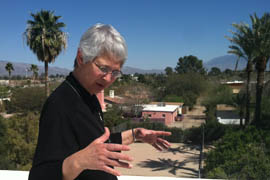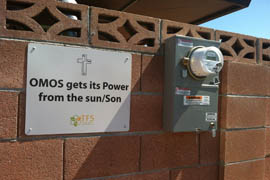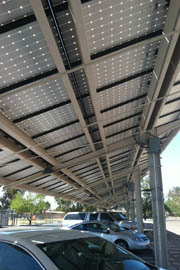Cronkite News has moved to a new home at cronkitenews.azpbs.org. Use this site to search archives from 2011 to May 2015. You can search the new site for current stories.
Tucson churches join movement linking religion, sustainability
TUCSON – You can see them from the busy street: tall, wide beams towering over a parking lot, propping up a massive diagonal plane slanted toward the sun. About 100 feet away stands a 73-year-old, three-story stucco monastery.
Below the structures, Sister Ramona Varela watches as the last square solar panel is placed on the canopy. In a few weeks, she and her fellow nuns will bless the newest addition to the Benedictine Sisters of Perpetual Adoration’s home: renewable energy.
Sustainability and spirituality aren’t typically thought of together, but a movement in southern Arizona has dozens of churches of various faiths taking steps toward energy efficiency and renewable energy – not only to save money, but also to complement their long-standing doctrines of caring for the Earth.
“It’s in our genes to help the environment, to take care of God’s earth,” Varela said, smoothing a crease on her black, full-body dress – a more modern, casual version of the nun’s uniform, without the white bib or heavy veil.
The monastery has two Toyota Prius hybrid cars and two water wells, one below ground and one above to catch rain. Inside, the lightbulbs have been replaced with energy efficient versions. On the third floor, the sisters use a solar-heated water pump for their washing machines. That water is recycled as gray water for their gardens.
Hank Krysik, a Tucson architect working with the Pima County Interfaith Council, serves as an energy efficiency and renewable energy consultant for the monastery, as well as two dozen other southern Arizona houses of worship, including the Temple Emanu-El, a synagogue less than a mile away from the monastery.
Krysik began his work at Our Mother of Sorrows, his own church and the first religious organization in Tucson to adopt a large-scale plan for energy efficiency and renewable energy.
“As churches, we’re still affected by the economy. We still have to pay utilities,” he said. “And as the economy has been challenged, so has the ability for people to put another penny in that collection plate.”
Three years ago, Our Mother of Sorrows established a committee to look for ways to reduce the church’s power bill. The process began with low-hanging fruit, Krysik said: installing programmable thermostats, occupancy sensors and changing lightbulbs.
The small fixes led to bigger ideas, like installing solar panels on canopies over the parking lot and on the property’s roofs, Krysik said.
Renewable energy now covers about 50 percent of the church’s electrical use, with no upfront cost to the church other than the lease for the panels, which it hopes to pay off in a few years.
The church payed for its installations through incentive programs offered by Tucson Electric Power, a utility required by the Arizona Corporation Commission to reduce its power sales by 22 percent by 2020 and generate 15 percent of its energy from renewable resources by 2025.
At Our Mother of Sorrows, the panels also serve to plant a seed of environmental awareness in younger generations of Roman Catholics. The church houses a school, and hordes of children walk, skip and run past the parking lot’s solar panels each day.
“It truly does have a rippling effect,” said Krysik, who fuels his truck with vegetable oil. “It becomes a behavior.”
Monsignor Tom Cahalanem, pastor at Our Mother of Sorrows, said he believes there is a clear connection between sustainability and spirituality.
“If we accept that we are gifted and blessed by God, the relationship is like hand and glove,” he said. “God has entrusted creation to us, and we are tapping into that source of God’s gift.”
Tod Swanson, senior sustainability scientist and associate professor of religious studies at Arizona State University, said it’s natural for Judeo-Christian faiths to be mindful of the environment, as caring for the Earth is a major tenet of the creation story in Genesis.
While solar-paneled churches are popping up across the country, Swanson said he doesn’t expect to see the trend reach more evangelical and conservative groups, many of whom believe the world will end soon and that preserving the environment isn’t a fruitful effort.
“But then there’s another group of churches … that put more emphasis on doing what they see is the will of God in this world,” Swanson said. “There’s a sense of duty for people to take seriously their role as stewards and caretakers of creation.”
As for Krysik, becoming a consultant for churches has helped him better understand his own religion.
“I can use my profession and faith together to make a difference,” he said. “Maybe this is what I’ve been called to do.”









